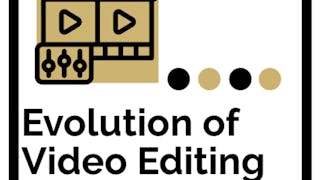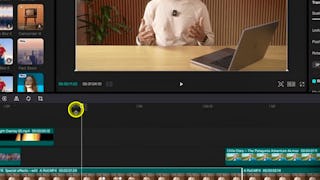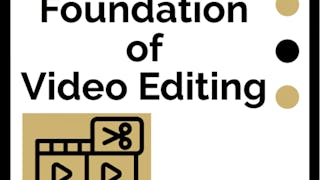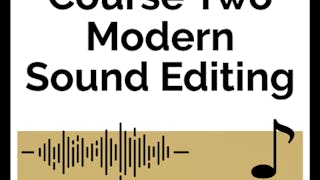Master the post-classical editing techniques that helped shape the MTV Style, characterised by fast, rapid cuts and non-linear narratives. Discover ways to enhance your visual stories, utilising visual effects like wipes and intentional jump cuts more to evoke an emotional response through visual impact. Delve into the psychology of editing and learn how to create tension and suspense. Learn the Rule of Six as conceived by award-winning editor Walter Murch and understand why we cut. Explore social media editing, using editing software that you can use to create engaging, short-form videos with elements like quick cuts, kinetic typography, music and sound effects to hook viewers immediately. Dive deeper into what makes a cut invisible, applying natural transitions that are created in-camera. Identify the different types of match cuts that shape meaning within a narrative. Examine some of the captivating editing techniques used by film director Edgar Wright. Understand the many uses of sound in your edits and why it’s important to get the eyelines to match. Finally, demonstrate your knowledge by editing a short video with footage we provide, and share it amongst your peers. At the completion of this course, you will be able to highlight your new abilities in a range of work and add to your portfolio.
通过 Coursera Plus 解锁访问 10,000 多门课程。开始 7 天免费试用。


您将学到什么
Identify the editing techniques that characterize the MTV style and analyze their impact on audience engagement.
Explain the psychology of editing and analyze how it influences the creation of tension and suspense.
Describe the Rule of Six and evaluate the factors that motivate an effective cut.
您将获得的技能
要了解的详细信息
了解顶级公司的员工如何掌握热门技能

积累特定领域的专业知识
- 向行业专家学习新概念
- 获得对主题或工具的基础理解
- 通过实践项目培养工作相关技能
- 获得可共享的职业证书

该课程共有3个模块
Welcome to the first module in Modern Video Editing Techniques, which introduces you to modern video editing techniques. We begin with a description of the post-classical era of editing, which is sometimes referred to as the MTV Style, defined by its fast-cutting, non-linear narratives, and many jump cuts. We also ask whether short-attention spans in modern audiences justifies the use of fast cuts, which you can discuss amongst your peers in our Discussion Prompt. Also, explore the psychology of the edit with master storytellers like Stanley Kubrick and Alfred Hitchcock. We’ll look into some of the editing techniques that can inject tension and fear or produce a sense of calm and contemplation. Finally, you’ll be introduced to Walter Murch, an award-winning editor, who wrote the book on editing. Murch’s Rule of Six will help you know when and why to make the edit.
涵盖的内容
6个视频3篇阅读材料1个作业1个讨论话题
In this second module, we’ll explore the editing techniques used to captivate consumers of social media videos. We’ll explain why it’s necessary and crucial to hook your audience’s attention right away, and how you might do this. Creating such videos doesn’t require months of learning. We’ll recommend certain editing apps that will help you create outstanding videos. Learn about the many transitions you can use, including some that you can innovate yourself to spice up your videos. We’ll introduce to kinetic typography as an editing technique that will make text on screen more visually appealing, and we’ll tell you more about the use of jump cuts as a stylistic choice.
涵盖的内容
5个视频3篇阅读材料1个作业
In this third and final module, we’ll revisit the “invisible cut” and the ways that you can edit continuity seamlessly. Natural wipes are a common fixture in traditional editing, and we’ll look closely at some examples of this technique in film. As an exercise, we’ll provide the footage so you can experiment with natural transitions yourself. We’ll also dive back into match cuts, identifying several different types that can infer certain connections between themes or ideas. We’ll introduce you to the fast cuts and incredible transitions of filmmaker Edgar Wright. He learned that editing begins not in post-production, but in pre-production with the use of animated storyboards. We’ll also revisit the most common sound bridge technique – the J-Cut, and how they can be great ways to smooth out otherwise jarring edits or even to jump forward in time. Finally, learn about the use of eyeline match to help motivate the edit. We’ll show you several examples where the eyeline matches must follow the 180-Degree Rule. In your final assignment, apply the techniques you learned during this specialisation to edit a short narrative. As always, we’ll provide the footage, you have all the fun! Thanks for joining us on this insightful exploration into the evolution of video editing techniques!
涵盖的内容
6个视频5篇阅读材料1个作业2次同伴评审
获得职业证书
将此证书添加到您的 LinkedIn 个人资料、简历或履历中。在社交媒体和绩效考核中分享。
从 Music and Art 浏览更多内容
 状态:免费试用
状态:免费试用University of Colorado Boulder
 状态:免费试用
状态:免费试用 状态:免费试用
状态:免费试用University of Colorado Boulder
 状态:免费试用
状态:免费试用University of Colorado Boulder
人们为什么选择 Coursera 来帮助自己实现职业发展




常见问题
To access the course materials, assignments and to earn a Certificate, you will need to purchase the Certificate experience when you enroll in a course. You can try a Free Trial instead, or apply for Financial Aid. The course may offer 'Full Course, No Certificate' instead. This option lets you see all course materials, submit required assessments, and get a final grade. This also means that you will not be able to purchase a Certificate experience.
When you enroll in the course, you get access to all of the courses in the Specialization, and you earn a certificate when you complete the work. Your electronic Certificate will be added to your Accomplishments page - from there, you can print your Certificate or add it to your LinkedIn profile.
Yes. In select learning programs, you can apply for financial aid or a scholarship if you can’t afford the enrollment fee. If fin aid or scholarship is available for your learning program selection, you’ll find a link to apply on the description page.
更多问题
提供助学金,
¹ 本课程的部分作业采用 AI 评分。对于这些作业,将根据 Coursera 隐私声明使用您的数据。






